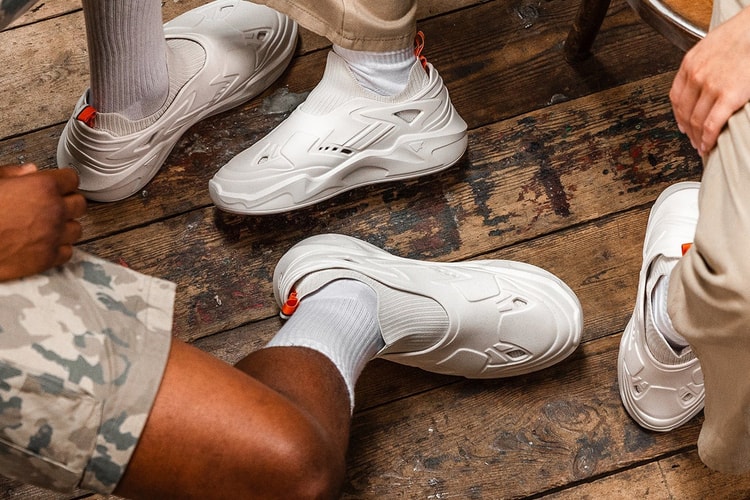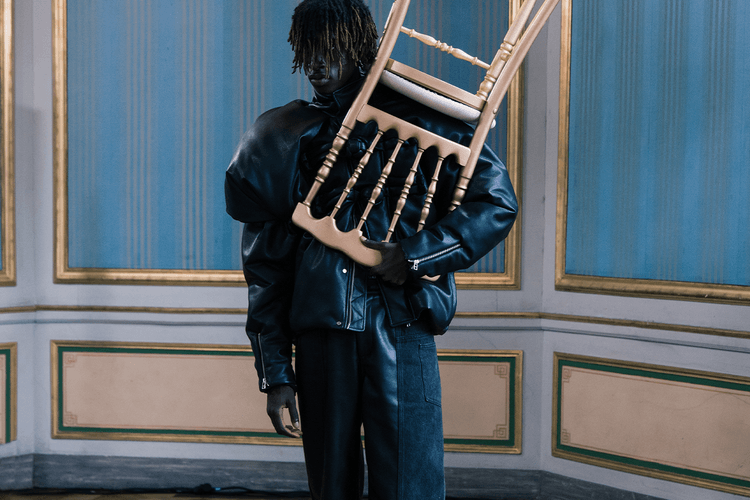Muddycap is Designing Chairs That Can't be Sat on
For ‘Hypebeast Magazine’ Issue 31, the cloaked designer sheds light on his reality-blurring creations.
Chairs are the bread and butter of contemporary design, but as a ubiquitous item we all live with, they go unnoticed—a humble victim of their own usefulness. History shows that our (mostly) four-legged friends first turned up in Ancient Egypt some 5,800 years ago. Back then, they were used as a symbol of ranking—and the higher an individual was ranked, the taller the chair would be. Since then, the chair has been reinterpreted to the nth degree. An evolution of the benches and stools that came before it, the addition of a backrest and arms to chairs in Ancient Egyptian times seemingly began the design world’s obsession, prompting the creators of past millennia to come up with their very own blank canvas.
Over time, designers, architects and artists alike have used the chair as a means of expression. In their minds, form and function wrestle with one another. Some aim to create the most useful and comfortable, with others hoping their creation becomes an icon in its own right. Grappling with the correct balance has brought us some of the most famous design objects in existence— from Ludwig Mies van der Rohe’s Barcelona Chair to the humble white plastic Monobloc found stacked up the world over. “A chair is a very difficult object, a skyscraper is almost easier,” Mies van der Rohe—a designer of both—once famously said. So why does the chair continuously come back into focus?
“Chairs are essential in our lives,” says Muddycap, a designer based in South Korea, who has recently risen to prominence across Instagram with an account dedicated to abstract interpretations of the home staple. “When I first started my account, I barely knew about chairs and wasn’t really interested in them—I was also making tables, lights, shoes, etc.—but the audience was more interested in chairs than anything else.”
“A chair is a very difficult object, a skyscraper is almost easier.” —Mies van der Rohe
With this in mind, Muddycap—a moniker used by the designer in order to remain anonymous—began spending his time transforming chairs into works of art in their own right, and sharing them through his @muddycap handle. His creations have amassed more than 65,000 followers on Instagram since he began posting pieces inspired by anything from the Nike SB logo to the work of Virgil Abloh in early 2020. Since then, his craft has come a long way—both technically and in terms of forging a style that is instantly recognizable as his own.
As someone who’s made his name on Instagram, it’s fitting that we began our conversations over DM’s when I asked the cloaked designer if we could have a general chat about his process and creative background. Having majored in art at university, Muddy—as I’m told it’s OK to call him—became disillusioned with the curriculum on offer. “There were more things I wanted to do, and my interests were elsewhere,” he says. But those interests required both time and money, two things he was lacking in. It wasn’t until he began to learn about 3D art and renderings that he found a medium for his creative pursuit. “I started making things in 3D with my friend’s old laptop and posted them on Instagram,” he says. “It was so convenient. With the laptop, I was able to make anything, anytime, anywhere.”
Now, his process always begins with an abstract idea, and if you look at some of his most recent pieces, you’ll notice that these ideas can range widely, from a mousetrap to a donut stack. Having set his concept, and roughly figured out the shapes associated with what he has in mind, Muddy begins embodying and visualizing the ideas to turn it into a 3D model. “I don’t start working with the 100% finished shape in my mind,” he says, “so the longest part of the process is forming the details.” Once the modeling is done, he moves on to rendering. During this process, materials and colors are applied to the 3D model. “I don’t usually think about the colors before this stage, so they depend on the mood at that time.” Muddy says. “Most of my work is a little spontaneous.” When all is finished, and Muddy is happy with the result, he names the artwork and uploads it to Instagram, where the likes and the comments roll in thick and fast. Many followers continue to be surprised that the chairs aren’t real, praising Muddy’s ability to create realistic 3D models, while others beg him to make them a physical reality.
The level of abstraction varies from design to design. Take, for example, the NS Chair, which combines a chrome frame with an acetate back and seat. One of Muddy’s more simple pieces, you can draw parallels between this and design greats, like Giancarlo Piretti’s folding Plia chair. The origins of others are more difficult to pin down, and rather than taking physical cues from existing objects appear to be born straight out of Muddy’s brain. The Bone Chair sees a silver-toned skeleton trapped within a frosted material, while the Nature Chair depicts a mushroom cluster growing within its glass-clear structure.
“Chairs are essential in our lives.” —Muddycap
A notable trait that comes across when chatting to Muddy is a certain degree of humility. Spend enough time in the design industry and you’ll realize this is a rare occurrence, particularly in terms of those lucky enough to dominate its fairs, galleries and stores. Many of his answers to questions regarding his practice could be interpreted as somewhat naive, but in reality, they show a refreshing lack of pretense. Take, for example, Muddy’s sources of inspiration. “I do get influenced by my favorite designers, but I think most of the inspirations are from my daily life,” he says. “I get ideas from the songs I listen to, movies I watch and the food I eat. I also try to hang out more with my friends and experience new cultures.”
Even when alluding to his online popularity, Muddy makes clear that social media success was never the intention, and in fact, he uses the render process in preparation for making real-life creations. “Luckily, many people showed me love and support with the 3D chairs, but I still have more ideas in my mind to show,” he adds.
With computational design having the design industry firmly in its chokehold, many turn to a line of questioning that has developed from its relevance and potential (back when the only way to mock something up was through physical scale models), to the nuanced ways in which it can propel the industry forward, now that it is a widely used tool. For Muddy, it goes beyond his own needs. “It seems to be getting easier and easier to digitally implement an individual’s ideas,” he says. “I see this creating more opportunities for people who were not easily approached, or gave up art due to various restrictions in the past.”
As a design journalist, my social channels are filled to the brim with concepts for furniture, interiors and architecture. But something about Muddy’s work feels different. Yes, many of his chairs rely on fantastical, eye-catching aesthetics that are well-versed in Internet trends, but it goes beyond that. “While the chairs are made in 3D, many of their points are based on reality to some extent. I try to express the elements that should be considered in the actual production process, such as proportions, materials and mechanisms.” To many, that probably sounds dull. But it’s this distinction that gives Muddy’s work that “is it or isn’t it real” edge over its physically impossible counterparts. Because they are kind of real, it makes you want them to actually be real even more. Luckily for us, the designer hopes to pick up tools and begin IRL construction on some of his pieces this year. “I want to see my friends and family sitting on my chairs,” he concludes.
HYPEBEAST Magazine Issue 31: The Circle Issue is now available on HBX.




























